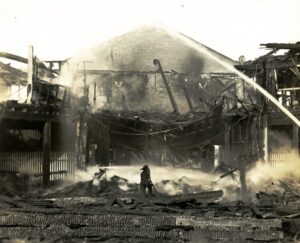Newport Beach and Its Many Dancing Shoes

Jill Thrasher
Sherman Library Director




Did you go dancing to celebrate the New Year? Well, if you had grown up in Newport Beach in the early years you would not have had to travel far because Newport Beach was a hot spot for dancing, starting with the iconic Pavilion on the Balboa Peninsula.
From 1920 to 1928 people from all over Southern California would hop on the Pacific Electric Red Car not only to go to the beach, but to also dance the night away. The dance floor was so crowded that a unique swing-style dance was created: The Balboa (sometimes called Pure-Bal). It was designed to take up a small space on a crowded dance floor with a two-step movement and shuffling of feet. The popularity of dancing at the Pavilion created a need for a bigger dance floor, so in 1928 the Balboa Amusement Company built the Rendezvous Ball Room in the heart of Balboa.
The Rendezvous was an immediate success. Dances were held six days a week throughout the summer but only Friday and Saturday during the offseason. Sadly, on January 27, 1935 it burnt to the ground. It then returned bigger and better in 1938, with the capacity to hold 1500 dancing couples on its newly rebuilt 12,000 square foot dance floor.
During the late 1930s and 1940s the Rendezvous was packed. Admission was 25 cents for men and 5 cents for ladies, or one could purchase a book of 12 dances for 50 cents. Because of the dancing styles, such as the Jitterbug, only so many couples could safely be on the dance floor at one time. Couples would use their tickets to get onto the floor and red velvet ropes were implemented for crowd control. Stan Kenton, Nat King Cole, and Benny Goodman frequented the Rendezvous’ performance lineup and drew crowds from all over California.
As the years progressed, the Rendezvous was there to witness the height of big band jazz, the rise of early rock and roll, and, of course, the birth of surf rock. Dick Dale and The Del Tones, often thought of as the inventors of surf music, got their start and fame in the 1950s and 1960s playing at the Rendezvous. Teenagers from all over would fill the Rendezvous to hear him play. Tragically, in 1966, the Rendezvous would succumb to fire once again, and this time, its doors never reopened.

